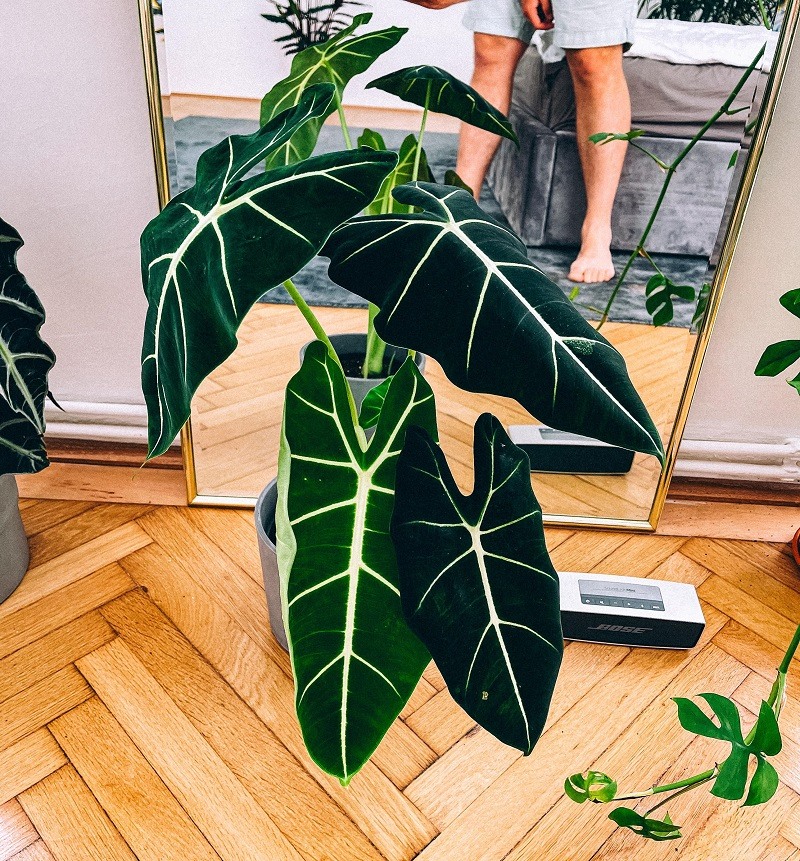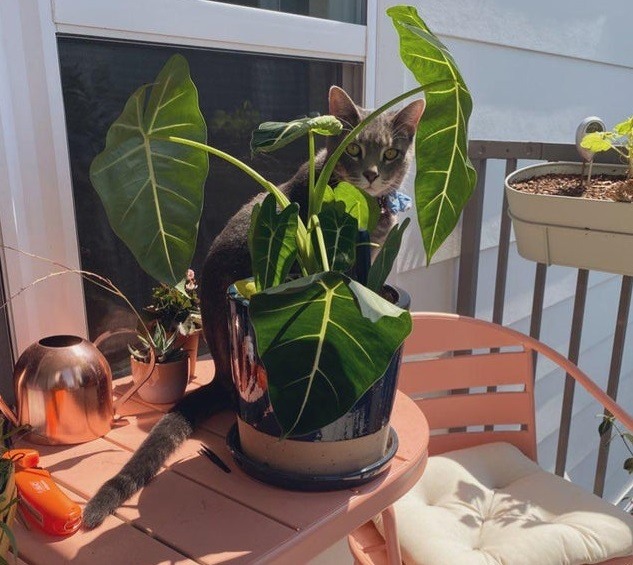Alocasia frydek (alocasia micholitziana) is affectionate alocasia green velvet. This gorgeous alocasia variety is growing in demand across the world. Thanks to its deep dark-green leaves with prominent lateral veins.
Alocasia frydek care involves the provision of bright indirect sunlight, high humidity, well-draining soil, and regular watering. Keep the indoor temperature around 65-85oF (18-30oC) and feed the plant monthly during the growing seasons.
This article provides a comprehensive alocasia frydek care and techniques of dealing with common problems. Take the time to read through this alocasia frydek indoor care for better growth. Let’s find out together now.

What Does Alocasia Frydek Looks Like?
The alocasia frydek green velvet is an evergreen tropical plant that belongs to the Araceae family. It grows under the canopy in the tropical rainforest.
Frydek is native to the Philippines and is also called the elephant ear plant. Other popular alocasia types with similar features to frydek are Amazonia, Polly, and zebrina.
The alocasia green velvet has large arrowhead leaves with prominent veins. The deep green leaves’ background tends to contrast with the white lateral veins.
Alocasia frydek leaves grow up to 45cm long under proper growing requirements. Besides that, this fast-growing tropical plant can reach 3ft. tall.
Alocasia micholitziana variegata is a rare and beautiful cultivar. The bright yellow or golden yellow variegation marks a lasting impression.
The green velvet usually blooms in its native environment to produce a long cream-colored spathe surrounded by a leaf-type bract that curls down to display it.
The entire tropical plant contains calcium oxalate crystals that are poisonous to pets and humans if ingested. Be sure to keep your favorite alocasia species away from pets and children.
You May Also Like: How to Care for Alocasia Amazonica
Alocasia Frydek Care Details
| Origin | The Philippines |
| Scientific Name | Alocasia micholitziana frydek |
| Common Names | Green velvet alocasia Alocasia frydek Elephant ear alocasia Velvet alocasia |
| Maximum Growth (approx.) | 3 feet tall. |
| Light Requirements | Bright indirect sunlight. 1-2 hours of early morning and late evening direct sunlight is another option. |
| Watering Needs | Loves moderate soil moisture. Water the plant once the 2-3 inch topsoil is dry. |
| Potting Soil Requirements | Fertile and well-draining soil. Mix 60% peat, 30% perlite and 10% compost. |
| Temperature Range | 65-85oF (18-30oC). Temperature below 60oF (16oC) will trigger dormancy. |
| Fertilizer Application | Feed the frydek plant every month with regular fertilizer. (Check Best Deals on Amazon). |
| Humidity Requirements | Maintain humidity above 50%. Low humidity levels make the leaf tips and edges turn brown. |
| Flowering | Indoor frydek rarely bloom. The outdoor counterpart produces an unimpressive spadix with a light green spathe. |
| Pruning and Maintenance | Minimal pruning requirement. But remove the old or damaged foliages. |
| Propagation | Division of larger plants in the springtime. |
| Repotting | Once every 2-3 years due to a root-bound issue |
| Pests and Diseases | Pests: Spider Mites Diseases: Root rot due to overwatering. |
| Toxicity | Poisonous to humans and pets if ingested. |
How to Take Care for Alocasia Frydek
Alocasia Frydek Light Requirements
Alocasia frydek plants thrive in bright indirect sunlight. The foliages are too sensitive to sunlight intensity. Too much or little light might harm the leaves.
I recommend placing the houseplant in a region that receives bright indirect sunlight. Avoid direct sunlight since it can cause scorching.
The low light condition makes frydek leggy and fosters a slow-growth rate. The environment can also make alocasia leaves turn yellow and increase the risk of overwatering.
How to Water Alocasia Frydek
Growing alocasia green velvet as a houseplant can be an exciting and daunting experience. The plant has thick stems and petioles that give succulent properties.
But these succulent features do not make the plant drought-resistant. Keep the potting soil slightly moist without getting soggy or dry.
Overwatering causes root rot and under-watering result in plant dehydration. Water your houseplant once or twice a week during spring and summer.
The golden rule is to inspect the soil moisture content before watering. If the 2-3 inches of topsoil is dry, soak the potting mix until water runs through the drainage holes.
Best Soil for Alocasia Frydek
Alocasia frydek does best in fertile and well-draining potting soil. The potting mix should also have the ability to hold moisture for an extended period.
The addition of organic matter or compost helps to boost soil fertility. The nutrients make the houseplant experience vegetative growth.
Use a mixture of 60% peat, 30% perlite, and 10% compost. Ensure the combination meets the soil requirement for alocasia plants.
Alocasia Frydek Temperature Range
Alocasia green velvet is accustomed to the tropical rainforest condition. The temperature in this environment ranges from 65-85oF (18-30oC).
Every houseplant enthusiasts need to ensure the indoor temperature is similar to its native environment. The temperature range keeps the plant healthy and happy.
Any temperature below 60oF (16oC) will trigger dormancy. If the freezing temperature prolongs for an extended period, the houseplant is likely to die.
Keep the alocasia frydek away from hot and cold drafts. It will help to reduce the risk of leaves yellowing and dying.
Alocasia Frydek Humidity Requirement
Higher humidity levels make the alocasia frydek stay healthy and happy. The houseplant thrives when the humidity level is above 50%.
Alocasia frydek leaf tips and edges turn brown under low humidity. The green velvet alocasia ends up losing its stunning and vibrant foliage colors.
Get a digital hygrometer (Check the Best Deals on Amazon) to help in monitoring indoor humidity levels. Use a humidifier to boost the indoor humidity to meet plant requirements.
Alocasia Frydek Fertilizer
The green velvet needs is a heavy feeder than other alocasia varieties. Apply fast-acting and water-soluble fertilizer every 3-4 weeks during spring and summer.
Dilute the fertilizer to enhance faster absorption. Stick to the fertilizer formula instructions to avoid ruining your favorite houseplant.
I prefer the use of organic fertilizer due to the presence of worm castings and compost. These nutrients facilitate vegetative growth and leaf coloration.
Alocasia Frydek Flower
Indoor green velvet alocasia does not bloom. The striking foliages are the reason behind the rapid growth in demand across the world.
The alocasia velvet is an aroid that produces spathe and spadix. These two components are regarded as alocasia flowers. The spadix is fleshy and consists of multiple small flowers.
These unimpressive flowers are common under warm and humid conditions. I prefer cutting the flowers to conserve energy for other vital parts.
Pruning and Maintenance
Minimal pruning requirement is part of alocasia frydek care. It involves the removal of old or damaged leaves. These foliages usually shrivel, turn brown and droop.
Pruning the dead leaves allows the houseplant to stay beautiful and happy. Use a sharp and sterilized blade to remove these old foliages.
Alocasia Frydek Propagation
Alocasia green velvet propagation is undertaken by dividing a mature plant. I recommend undertaking the task in spring or early summer due to active growth.
This alocasia velvet is delicate and sensitive to root disturbances. Remove a mature alocasia frydek from a pot and separate the offset from the parent rhizome.
Plant the offset in a new container with potting mix. Water the houseplant and provide ultimate growth care. Be sure to place it near bright indirect sunlight to trigger faster growth.
How to Repot Alocasia Frydek
Alocasia green velvet thrives in small pots that are proportional to its size. The houseplant does not require regular transplant since it is less vulnerable to root-bound.
Repot the green velvet due to root-bound signs. Investigate the plant roots for any signs of diseases before repotting.
Use a pot that is slightly bigger than the current one. Exercise ultimate care when repotting to avoid damaging the roots. I prefer repotting the green velvet in spring.
Common Problems and Solutions
Pests
Alocasia frydek is more vulnerable to aphids, spider mites, scales, and mealybugs. These sap-sucking creatures usually ruin the plant’s health and well-being.
Isolate the plant from other houseplants to prevent pests from spreading. Use insecticidal soap or neem oil to eliminate these insects from the plant.
Diseases
Alocasia frydek is not susceptible to common plant diseases. But overwatering may increase the risk of bacterial leaf and root rot.
Choose the best pot with drainage holes at the bottom and well-draining soil. Schedule a watering routine to avoid inappropriate soil moisture.

Frequently Asked Questions
Is Alocasia Frydek Rare?
Yes. This glamorous specimen with elegant touch is rare in the United States and Canada due to weather-climate dynamics.
Is Alocasia Frydek Indoor Plant?
Yes. The green velvet thrives under the canopy in its native habitat. The indoor condition can allow the alocasia velvet to flourish.
Is Alocasia Frydek Fast Growing?
Alocasia frydek is a fast growing tropical plant. Addition of compost in the potting soil helps to facilitate faster growth.
Why Is My Alocasia Frydek Drooping?
Overwatering and under-watering are the leading cause of the problem. Overwatering causes root rot while under-watering results in wilting.
Other possible causes are transplant shock, temperature stress, over-fertilization, pests, and diseases. Investigate your plant to determine the exact cause.
Is Alocasia Frydex Toxic to Pets and Humans?
Yes. Alocasia green velvet contains calcium oxalate crystals. These chemical compounds are toxic to cats, dogs, and toddlers if ingested.
Why Are My Alocasia Frydek Leaves Turning Yellow?
Alocasia green velvet leaves turning yellow occur due to overwatering, excessive direct sunlight, and temperature stress. Other causes are under-fertilization and acclimation.
Take the time to investigate your green velvet to identify the exact cause. Try to tweak the growing condition and fix the reasons behind the yellow leaves.
Conclusion
Alocasia green velvet is my favorite alocasia species. Thanks to its striking and vibrant foliages that make a bold statement in any space.
How to care for the alocasia green velvet involves the provision of bright indirect sunlight, moderate soil moisture, well-draining potting mix, and high humidity.
Ensure the indoor temperature ranges from 65-85oF and feeds the houseplant every 3-4 weeks during the growing season. Keep the houseplant away from hot and cold drafts.
